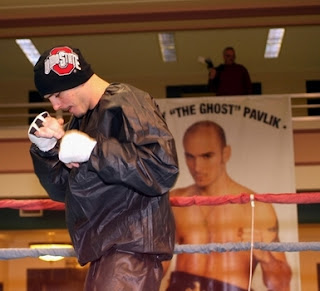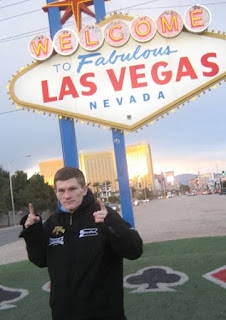
The last time I saw Ray "The Rainman" Austin, the cool March air of the New England winter was still blowing through the forests that surround the Foxwoods Resort and Casino. According to the calendar on the wall it was winter, but the sweet smell of spring was in the air. The gray skies held dark clouds, and it had begun to rain.
Later in the evening, Diego Corrales and Joel Casamayor would again show their hatred by pounding away on each other’s skulls. But first, there was a tedious undercard to wade through and it was painstakingly boring as the prelims these days have a tendency to be.
Gerry Cooney was in the audience, doing what he has done best since that magical June night in 1982 when he mixed it up in the desert with Larry Holmes at Caesars Palace. Cooney was in the stands glad-handing with the out of town crowd, signing every autograph and smiling just right for the lines of picture takers. He’s the only goodwill ambassador that boxing seems to have left these days.
And then we all heard it. It’s the unmistakable sound of leather slapping against skin that ricochets through the air like a gunshot. Your brain always makes your head whirl toward the sound. Ray Austin, from Cleveland, Ohio was up in the ring against a pug named Willie Williams from Atlanta, Georgia who is always brought in on nights such as this so he can fight just well enough to lose. It was a long, slow right hand that made the sound.
At 6’6" tall and 250 pounds, Ray Austin is never going to be fast. His punches come at his opponents like a log being dropped out of a second story window. His punches plow through their target, and he’s got the type of body that looks bigger than what the tape measure tells you.
In only ten days, from Mannheim, Germany, 36 year-old Ray Austin is getting a Rocky Balboa-like shot of a lifetime to fight for the heavyweight championship of the world against IBF titlist Wladimir Klitschko.
At the same time that Wladimir Klitschko was winning his Olympic gold medal at the 1996 Atlanta Olympics, Ray Austin had recently been released from a stint in prison and he was employed as a burger flipper at a Wendy’s fast food restaurant in East Cleveland, Ohio.
With an ugly pro record of 24-3-4 (16)KO, Ray Austin never had the opportunities in life or in the sport of boxing that Wladimir Klitschko has had. Klitschko was an Olympic darling and is a product of the old Soviet sports system. Growing up, Klitschko had access to the best training facilities, expert coaching and he fought the best amateur boxers in the world. When he turned to the professional ranks after winning Olympic gold he did so with the heft of a wealthy contract and a top-flight German promotional team. Klitschko also has a PhD, in Sports Science from the University of Kiev. It’s where he gets his nickname, "Dr. Steelhammer".
Ray Austin, on the other hand, was a high school dropout and a product of the streets of Cleveland, Ohio. His amateur career consisted of barenuckle fights fought under dim streetlights on dirty street corners. "There is no way I could say how many street fights I was in because sometimes I got into more than one per day," claims Austin. "I was always fighting back then. I had no choice."
Austin comes from a family that fought. His father, Robert Bolden, a former construction worker who is in his sixties, is a giant, hulk of man at 6’7" tall. He fought mainly in the streets but he’d sometimes lace up the gloves and head into the gyms that used to dot the Cleveland landscape. Then there is Ray’s uncle, Bo Bolden, who fought as an amateur and briefly as a professional. They’re the kind of men, even at their age, you wouldn’t want to mess with.
Despite his professional successes, Ray Austin says his most memorable fight came when he was only 16 years old. It was the fight that would get him kicked out of Shaw High School in his sophomore year. "There was a guy in the neighborhood who used to beat everybody up," Austin recalls. "I knew the time would come when I’d have to fight him, so I started working out. At that time of my life, I was always around guys in the game anyway, and I used to go with them to the gym. When the time came to fight the guy, I was up for the challenge. He thought I’d be easy, but I knocked him out with about three punches. It was then I thought that maybe I should take this sport seriously. I’d played a lot of football and basketball, but, after beating that guy up, I started going to gyms and watching fights on TV and I started working out with trainers that taught me patience."
Austin was a ship without a rudder as a young man. He has five children with three different women. He was married and had a son by the time he was 17 years old. He was a boy in a man’s body trying to make it in a man’s world.
Like many disadvantaged, inner-city youth, Ray Austin began to look around and he saw lots of guys his age who had a lot more material possessions than he did. Thick wads of one hundred dollar bills, the latest clothes and rivulets of sparkling jewelry. It was all very intoxicating.
Of course, they were dealing drugs in the back alleys and dark corners of East Cleveland and of course a young, impressionable Ray Austin wanted a cut of the action and the easy money. Nobody dared mess with him as he could beat two guys with one hand if he decided he wanted to. So, a young Ray Austin began selling crack on street corners.
Inevitably he wound up in prison. In 1988 he was arrested for stealing a car and for that he received a year in state prison. Shortly after he got out of prison, he was arrested for possession of what the cops believed to be three ounces of cocaine. It turned out not to be coke so Austin was off the hook. But, in early 1992, at only 21 years-old, Austin was busted for cocaine trafficking and spent most of the next four years behind the walls of the Lorain Correctional Institution in Grafton, Ohio. He didn’t box while he was in prison, but he could have had he wanted. He calls his years in the joint, "A f---ing nightmare."
By the time they unlocked the bars in late 1995, Ray Austin was nearly 26 years old and he had no prospects for the future. He had always been involved in street fights and he had been a fixture around the boxing gyms of Cleveland while following his father and uncle around. He had a loose relationship with Richie Giachetti who had trained heavyweight champions Larry Holmes and later Mike Tyson among many other top fighters.
By chance, Austin ended up turning pro at the late age of 27, but he lost his first fight, a four-round decision to Charles Hatcher in July 1998 in Columbus, Ohio. He weighed an out of shape 260 pounds and was paid $800.00 for his inaugural effort and had this to say about his first fight as a pro, "I was just a guy off of the streets with no amateur fights, and Hatcher had a lot more experience. Even though I lost, I came away confident that I could do better. I knew that if I worked harder and got in better shape, I could be a force."
It took several years, but over time Ray Austin developed into that force. He served as a sparring partner for some of the biggest names in the game and he fought and defeated a host of fringe contenders. Along the way, he was involved in some controversial decisions and won fights he should have lost and lost a few he should have won. He has never made any sort of real heavyweight money, but should he beat Klitschko the wallets of the world would be his for the picking. Nearly nine years after turning pro, Austin is now the #2 contender and Klitschko has been mandated to fight him.
Many of the so-called experts don’t give Austin much of a chance when he meets Klitschko in Germany. Klitschko is generally regarded as the number one heavyweight in the world and the best of the alphabet titlists parading as heavyweight champions. At age 30, Klitschko is close to his prime, has been ranked at or near the top of the division for nearly seven years and he has a very respectable pro record of 47-3 (42)KO.
When asked how he thinks things will go on March 10th, Klitschko, in his heavy Ukrainian accent, had this to say. "I won't underestimate Austin, but there will be no mercy in the ring."
Klitschko is a busy puncher that throws volumes of shots for a man that stands 6’6" tall and weighs 240 pounds. It could be an easy fight if he fights smart and used his left jab to keep the aggressive Austin off balance. However, Klitscho’s three losses have come by way of stoppage and he has suffered embarrassing knockout defeats and most pundits are not sold on his ability to take a heavyweight punch.
Austin says he’ll be ready for his first grasp at a major title and he openly discredits Klitschko’s last three opponents. "I’m not Calvin Brock," says Austin. "I'm not a 213-pound Chris Byrd, either. I’m a full-grown heavyweight. The last time Klitschko faced a man his weight was against Samuel Peter, who knocked him down three times while giving away five inches in height. Same thing when Lamon Brewster knocked him out."
Austin has the promotional representation of Don King on his side and King has a special affinity for Austin. King is also a product of the mean streets of Cleveland, Ohio and the self-proclaimed "world’s greatest promoter" also spent time behind the same Lorain Correctional Institution bars that Austin would 30 years later. At the press conference to announce the fight, King said that Austin, "Will end Klitschko’s career".
Whatever happens when Austin steps into the ring before nearly 14,000 Wladimir Klitschko fans is anyone’s guess. Maybe Ray Austin will throw a punch that comes all the way from the depths of the street corners of East Cleveland, Ohio and from behind the walls of the Lorain Correctional Institution. Maybe Wladimir Klitschko will fall flat at the feet of Ray Austin and a new champ will be crowned. And maybe then the dark clouds of life that Ray Austin has lived under for 36 years will lift – even if for just one day.
"I’m the most underrated heavyweight there is," says Austin. "And I guarantee some rain is going to fall on Klitschko when we fight."
For Ray "The Rainman" Austin, there ain’t no sunshine when he fights.
February 2007











